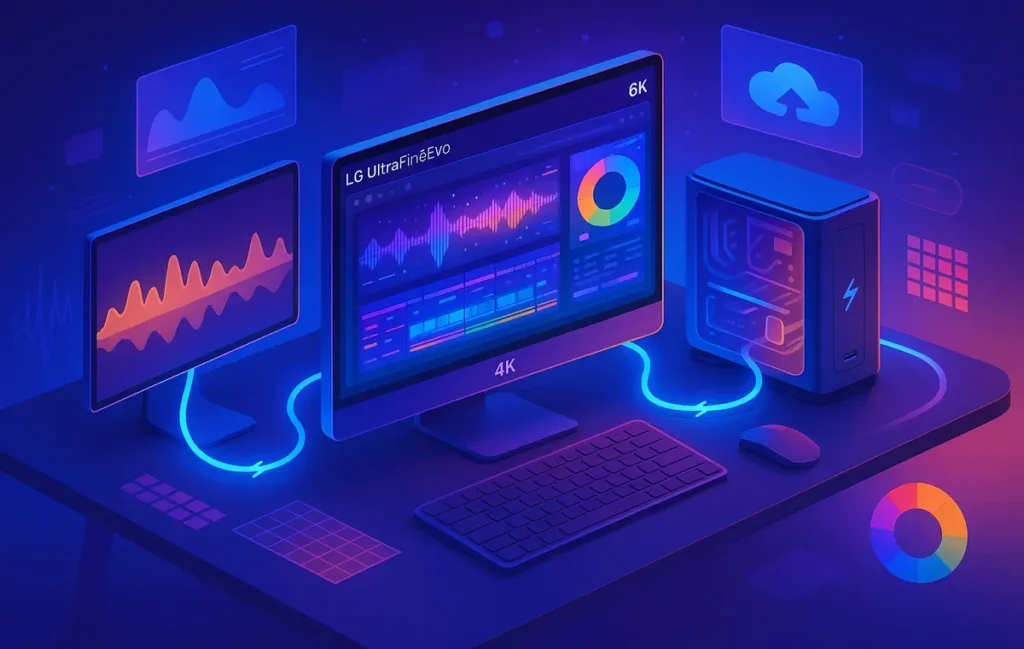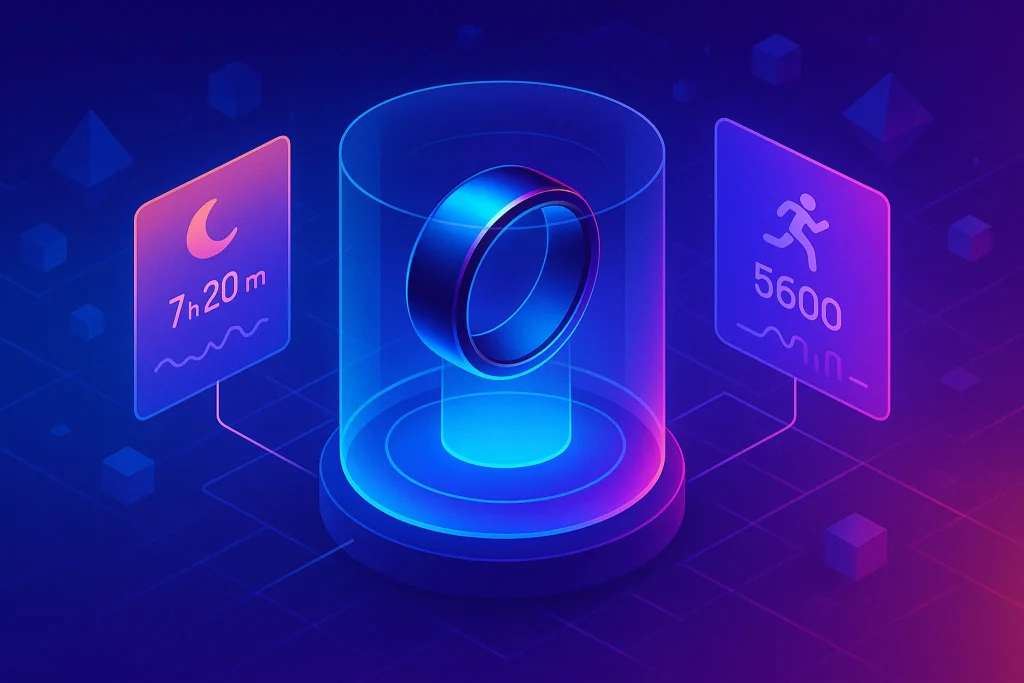🎯 Intro
Think of the last time you worked on a 4K monitor. You probably thought it was sharp, crisp, and more than enough for video editing, design, or even dual-monitor multitasking. But now, LG is rewriting the rules. The new LG UltraFine Evo 6K (model 32U990A) isn’t just another upgrade—it’s the world’s first 6K monitor with Thunderbolt 5 support, aimed squarely at professional creators who demand pixel-perfect clarity, flawless color accuracy, and lightning-fast data pipelines.
If you’ve followed our earlier breakdowns of Best OLED Monitors or Best Budget Monitors for Work From Home, you’ll know those posts explored value and affordability. This article, however, dives deep into the next frontier of display technology—a professional-grade tool designed for workflows where quality and speed can’t be compromised.
🔍 What Makes the LG UltraFine Evo 6K Special?
The Evo 6K comes with a 32-inch display boasting 6,144 × 3,456 pixels at 224 PPI, offering 2.56 times the pixel density of a standard 4K UHD screen. To put it in perspective, imagine editing a high-resolution film project where every pixel of detail matters—6K lets you see nuances invisible on a 4K monitor.
Color accuracy is another headline feature. Covering 98% of DCI-P3 and 99.5% of Adobe RGB, this monitor ensures faithful reproduction for professional colorists, photographers, and VFX artists. It arrives factory-calibrated for macOS with additional “Studio Mode” presets tailored for Apple workflows. Combined with its VESA DisplayHDR 600 certification, the Evo 6K delivers brightness and depth that match cinematic standards.
💡 Nerd Tip: Resolution matters, but color accuracy seals the deal. A 6K monitor without proper calibration is just overkill pixels.
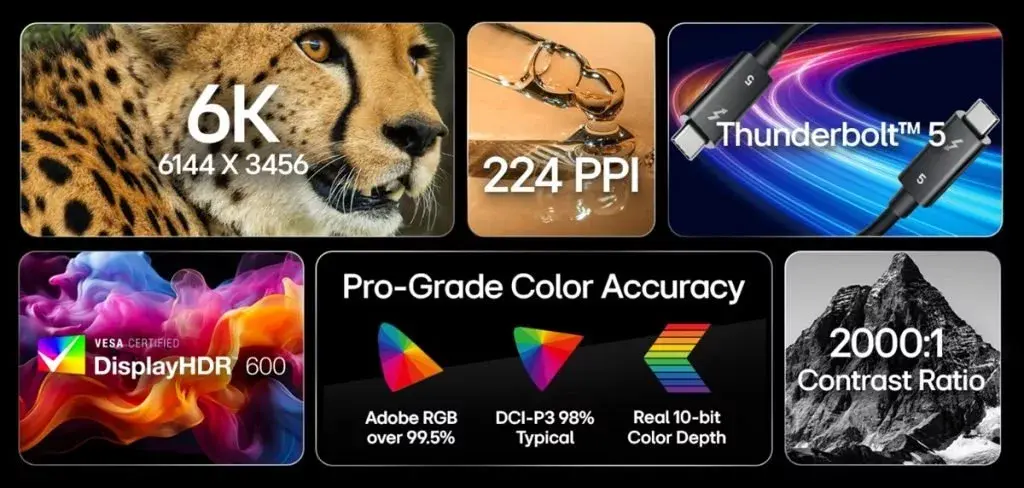
⚡ Thunderbolt 5 and Next-Gen Connectivity
While the 6K resolution grabs headlines, Thunderbolt 5 is the hidden star. This is the first professional monitor to embrace Intel’s next-gen standard, doubling bandwidth from Thunderbolt 4. What does that mean in practice?
-
Daisy chaining two 6K monitors becomes seamless, without bandwidth drops.
-
Creators can connect high-resolution displays, external GPUs, and massive storage arrays with a single cable.
-
Data-heavy workflows—like editing 8K RAW footage or rendering massive 3D environments—flow without bottlenecks.
Compared to setups we covered in How to Connect Two Monitors to a Laptop or How to Set Up a Dual-Monitor Gaming Station, this is not just about extra screens. It’s about a frictionless pipeline where data transfer, charging, and video signals coexist on one high-speed connection.
🎨 Real-World Impact for Creators
Professional workflows often choke when hardware can’t keep up. With 6K resolution and Thunderbolt 5, the UltraFine Evo 6K unlocks tangible gains:
-
Video editors can view full-resolution 6K or 8K content without scaling, streamlining precision edits.
-
Graphic designers benefit from wide color gamuts, ensuring print and digital outputs match expectations.
-
Developers and 3D artists gain vast workspace—two Evo 6Ks side by side equal nearly five 4K monitors in usable space.
-
Photographers working with 100+ megapixel files see every detail without lag.
The ROI is clear. In an industry where missed details can cost client trust, investing in higher resolution and better accuracy pays for itself.
🏆 Awards and Market Positioning
The UltraFine Evo 6K already earned the CES 2025 Innovation Award and the iF Design Award 2025, underlining its innovation in both performance and aesthetics. At an expected retail price of $2,140, it’s positioned as a high-end professional tool.
While consumer monitors fight on refresh rates for gaming, LG focuses this series squarely on professional creators. It’s not designed to compete with budget monitors but to stand alongside professional-grade displays from Apple and Eizo—only with Thunderbolt 5 giving it an edge.
⚖️ Comparison: 4K, 5K, and Now 6K
Let’s clarify why 6K matters:
-
4K UHD (3840×2160): Still the standard for most users. Great for gaming and casual work but limiting for detailed professional editing.
-
5K (5120×2880): Popularized by Apple’s iMac, offering better pixel density but still short of professional large-scale needs.
-
6K (6144×3456): Offers 2.56× the pixels of 4K, enough to view large projects without zooming or tiling windows.
If you’re happy with dual-4K setups from posts like How to Use Multiple Monitors Like a Pro, that’s fine. But if you want single-screen precision with Thunderbolt 5 daisy chaining for scalability, 6K is the natural next step.
💡 Optimizing a Workflow with UltraFine Evo 6K
Upgrading isn’t just about buying the monitor. To unlock its full potential:
-
Ensure your workstation has Thunderbolt 5 support.
-
Calibrate your color profiles to match your production pipeline.
-
Plan your desk for ergonomic use—6K resolution means more information density, so comfort matters.
-
If budget allows, pair two Evo 6Ks with daisy chaining for a near 10K workspace.
This is where the line between “luxury” and “necessity” blurs. For solo creators, one 6K is a powerhouse. For agencies or studios, multiple 6Ks chained together can replace entire editing suites.
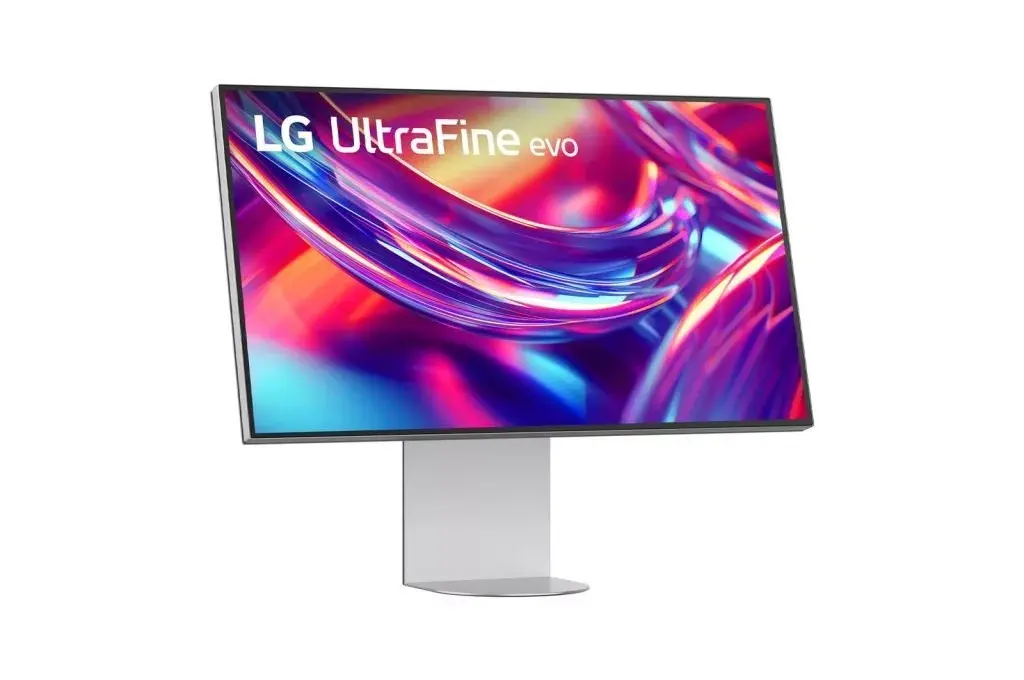
📈 ROI and Justification
$2,140 isn’t pocket change. But ROI for professionals is measured differently. If a colorist delivers more accurate projects, if an editor shaves hours off render checks, or if a designer closes a high-paying contract because their outputs look flawless—the monitor pays for itself in months.
When compared to productivity gains from affordable monitors like those in Best Budget Monitors for Work From Home, the contrast is stark. Budget monitors maximize value. The Evo 6K maximizes precision. The choice depends on whether your monitor is a tool of work or a window for browsing.
⚠️ Challenges & Limitations
Despite its brilliance, there are challenges:
-
Price barrier. At over $2K, it’s not for everyone.
-
Hardware requirements. Only Thunderbolt 5 devices can fully unlock its capabilities.
-
Overkill for casual users. If you mostly browse or stream, 6K will be wasted.
That said, these limitations are by design. The Evo 6K is a surgical tool, not a general-use gadget.
⚡ Elevate Your Creative Workflow
Looking for more workspace, better color accuracy, and faster pipelines? Explore professional-grade 6K and OLED monitors designed for creators who can’t compromise on detail.
🪑 Ergonomics & Workspace Design
A 32-inch 6K display is not just a technical upgrade—it’s a lifestyle change for your workspace. With such pixel density and expanded workspace, users often find themselves multitasking more aggressively, stacking timelines, reference images, and live previews side by side. But this productivity comes with ergonomic responsibilities.
Eye strain is one of the biggest risks with high-resolution displays. Sitting too close makes text razor-sharp but can fatigue your eyes over long editing sessions. Experts recommend a distance of at least 60–80 cm for a 32-inch monitor, with lighting adjusted to reduce glare. Adjusting chair height and monitor arms becomes more critical with larger, heavier panels like the Evo 6K.
💡 Nerd Tip: Treat your 6K monitor as the centerpiece of your studio. Build your desk ergonomics around it, not the other way around.
🍏 Evo 6K vs. Apple Pro Display XDR
The obvious comparison is with Apple’s Pro Display XDR. Apple’s monitor offers 6K resolution (6016×3384), reference-grade color, and HDR brightness up to 1600 nits—but costs nearly $5,000 (without a stand). By contrast, the LG Evo 6K delivers similar resolution, near-identical color coverage (98% DCI-P3, 99.5% AdobeRGB), HDR 600 certification, and the added benefit of Thunderbolt 5 daisy chaining—all at roughly $2,140.
Where Apple wins is peak HDR performance and integration into macOS workflows. Where LG wins is price-to-performance and future-ready connectivity. For creators who need top-tier accuracy without a $5K price tag, the Evo 6K becomes a highly attractive alternative.
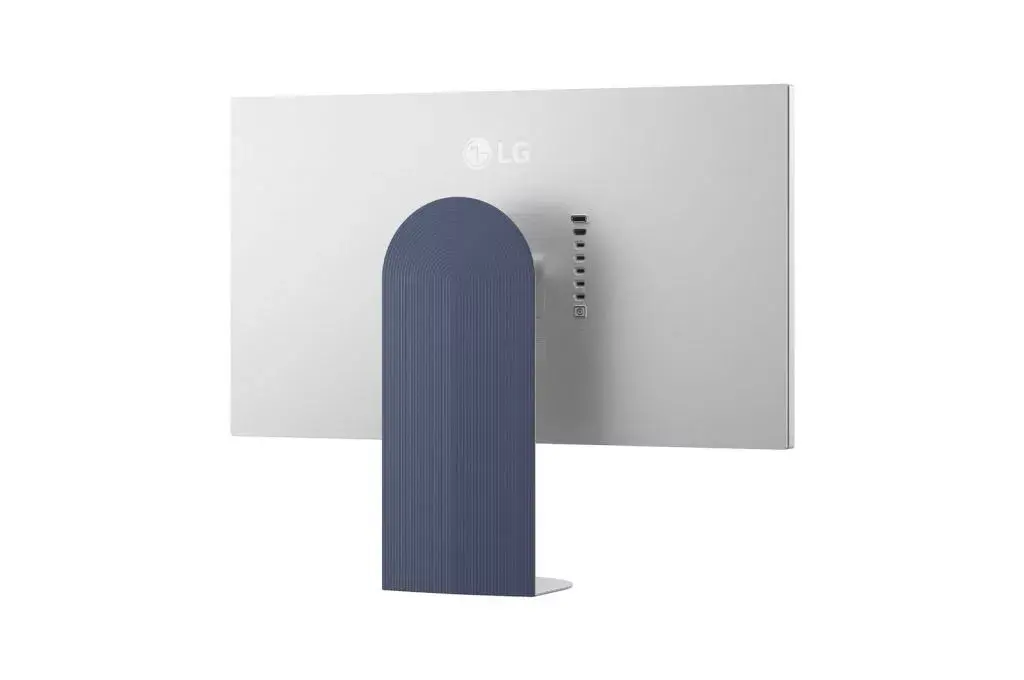
🔮 Future-Proofing Investment
Buying a $2,000+ monitor isn’t about this year’s projects—it’s about the next five. Content creation is moving beyond 4K fast. Netflix already requires 4K minimum for original productions, and 8K/12K cameras are entering the mainstream for cinema and VFX. A 6K monitor ensures your setup won’t bottleneck when higher-resolution workflows arrive.
Thunderbolt 5 support also means you won’t outgrow the connection standard anytime soon. As workstations adopt faster GPUs and storage pipelines, daisy chaining two 6K monitors or coupling them with external GPU boxes will feel natural instead of overkill. In short, the Evo 6K is a future-ready anchor for any professional studio.
🎤 Creator Impressions & Testimonials
Early adopters and creative professionals are already buzzing. In design forums, one photographer wrote: “Switching from dual 4Ks to the Evo 6K was like clearing fog off a window. Editing 100MP RAW files feels natural instead of cramped.”
Video editors testing the monitor in pre-release labs echoed similar sentiments: “Thunderbolt 5 daisy chaining is a game-changer. Running two 6Ks without a hiccup feels like the workstation finally caught up to my imagination.”
These voices highlight a recurring theme: the Evo 6K isn’t about specs on paper—it’s about reducing friction so creators can focus on craft.
🌱 Sustainability & Energy Use
High-resolution monitors often spark concerns about power consumption. While the Evo 6K naturally draws more energy than a standard 4K, it’s worth noting the trade-off. Two daisy-chained 6Ks can replace as many as four traditional 4K monitors, reducing overall clutter, cable sprawl, and even standby losses from multiple devices.
Energy-conscious creators can also pair the Evo 6K with eco-friendly setups: dimming brightness in daylight conditions, enabling auto-sleep timers, and using energy-efficient workstations. While not marketed as a “green device,” the ability to consolidate multiple displays into one ultra-high-resolution screen contributes indirectly to sustainability.
💡 Nerd Tip: Use brightness automation to save both your eyes and your electricity bill.
Want More Smart Display Insights?
Subscribe to our free newsletter for weekly guides on pro monitors, creative workflows, and future display tech—delivered straight to your inbox. No fluff. Just practical tips from NerdChips.
100% privacy. No noise. Just value-packed insights for creators and professionals.
🧠 Nerd Verdict
The LG UltraFine Evo 6K isn’t about trends—it’s about resetting standards. With 6K resolution, Thunderbolt 5 daisy chaining, and professional-grade calibration, it’s designed for creators who see their monitor as the most critical part of their workflow.
At NerdChips, our take is simple: if you earn your living in design, video, or content creation, the Evo 6K is more than a luxury. It’s a long-term investment in clarity, accuracy, and speed. For everyone else, it’s an inspiring glimpse of where display technology is headed.
❓ FAQ: Nerds Ask, We Answer
💬 Would You Bite?
Would you invest over $2,000 in a 6K monitor with Thunderbolt 5 for your creative workflow—
or stick with dual-4K setups until 6K becomes mainstream?
Crafted by NerdChips for creators who demand clarity, accuracy, and next-gen workflows.

